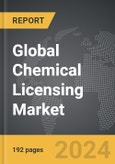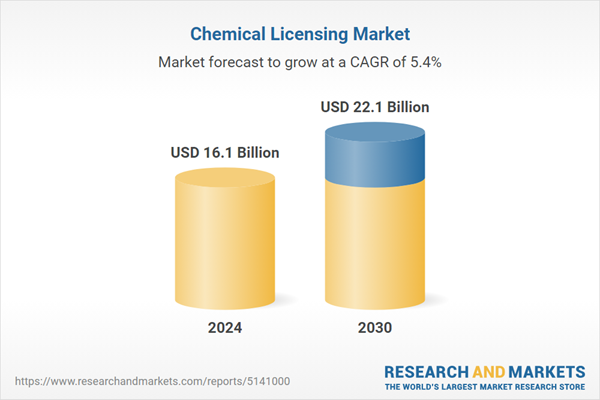The global market for Chemical Licensing was valued at US$16.1 Billion in 2024 and is projected to reach US$22.1 Billion by 2030, growing at a CAGR of 5.4% from 2024 to 2030. This comprehensive report provides an in-depth analysis of market trends, drivers, and forecasts, helping you make informed business decisions. The report includes the most recent global tariff developments and how they impact the Chemical Licensing market.
Segments: Type (C1 Derivatives, C2 Derivatives, C3 Derivatives, C4 Derivatives); End-Use (Oil & Gas, Chemical).
Geographic Regions/Countries: World; United States; Canada; Japan; China; Europe (France; Germany; Italy; United Kingdom; Spain; Russia; and Rest of Europe); Asia-Pacific (Australia; India; South Korea; and Rest of Asia-Pacific); Latin America (Argentina; Brazil; Mexico; and Rest of Latin America); Middle East (Iran; Israel; Saudi Arabia; United Arab Emirates; and Rest of Middle East); and Africa.
The analysts continuously track trade developments worldwide, drawing insights from leading global economists and over 200 industry and policy institutions, including think tanks, trade organizations, and national economic advisory bodies. This intelligence is integrated into forecasting models to provide timely, data-driven analysis of emerging risks and opportunities.
Global Chemical Licensing Market - Key Trends and Drivers Summarized
Why Is Chemical Licensing Critical for Industrial Growth and Innovation?
Chemical licensing plays a pivotal role in enabling industries such as petrochemicals, pharmaceuticals, and specialty chemicals to access cutting-edge technologies and processes that drive operational efficiency and innovation. Licensing agreements allow companies to acquire the rights to use proprietary chemical processes, formulations, or technologies developed by other firms, bypassing the need for extensive R&D investments. This exchange is particularly critical in industries where innovation is constant, and the demand for new chemical solutions is high. In sectors like petrochemicals, where the production of materials like polymers, fuels, and additives depends on complex chemical processes, licensing agreements provide access to the latest technologies that enhance yield, reduce costs, and ensure compliance with environmental regulations. By leveraging licensed chemical technologies, companies can stay competitive in global markets, meet the increasing demand for high-performance chemicals, and address specific challenges such as energy efficiency, sustainability, and waste reduction. In this context, chemical licensing has become a key driver of industrial growth and technological advancement, enabling businesses to scale their operations while staying ahead of industry trends.How Do Technological Innovations Influence the Chemical Licensing Market?
The chemical licensing market has been significantly shaped by technological advancements that offer more efficient, sustainable, and cost-effective processes. Innovations in catalysis, process optimization, and advanced manufacturing techniques have opened up new avenues for licensing opportunities. For instance, the development of new catalytic processes that enable the production of higher-quality chemicals with fewer byproducts is highly sought after in industries like petrochemicals and plastics. Similarly, advancements in green chemistry and environmentally friendly processes have become crucial for companies looking to reduce their carbon footprint and comply with stricter environmental regulations. These advancements are driving the demand for licensed technologies that prioritize sustainability without compromising on performance or cost-efficiency. Moreover, digital technologies, such as process simulation and real-time monitoring, are also influencing the chemical licensing market by improving the ability to track and optimize chemical processes. Licensees benefit from improved process control, better resource management, and increased operational transparency, all of which enhance the return on investment for licensed technologies. The constant push for technological innovation ensures that the chemical licensing market remains dynamic, with new opportunities emerging as industries seek to adopt the latest advancements to remain competitive.What Challenges and Regulatory Pressures Are Affecting Chemical Licensing?
The chemical licensing market faces a variety of challenges, most notably regulatory pressures and the growing complexity of global intellectual property (IP) laws. Stricter environmental regulations, particularly concerning emissions, hazardous waste management, and energy consumption, are forcing companies to adopt more sustainable chemical processes. As a result, there is a heightened demand for licensing agreements that include environmentally friendly technologies. However, navigating the regulatory landscape can be complex, as companies must ensure that licensed technologies meet not only their local regulatory requirements but also those of the regions where they operate. Intellectual property protection is another significant challenge, particularly in international markets where enforcing licensing agreements and protecting proprietary technologies can be difficult. Companies must ensure that their IP rights are adequately safeguarded through robust licensing agreements that detail usage rights, royalties, and obligations to avoid misuse or unauthorized reproduction of the licensed technologies. Additionally, the rapid pace of technological change means that licensed technologies may become obsolete or require frequent updates to stay competitive, which can complicate long-term licensing agreements. These challenges highlight the importance of due diligence and strong legal frameworks in the chemical licensing process.What Factors Are Fueling the Growth of the Chemical Licensing Market?
The growth in the chemical licensing market is driven by several factors related to technological advancements, industry demand, and regulatory shifts. One of the most significant drivers is the increasing pressure on chemical manufacturers to adopt more sustainable and energy-efficient processes. As governments worldwide impose stricter environmental regulations, companies are seeking licensed technologies that help reduce emissions, energy use, and waste production. This demand for greener solutions is particularly prominent in industries like petrochemicals, where advanced catalysts and process technologies can significantly reduce the environmental impact of production processes. Additionally, the rising complexity and cost of in-house research and development are pushing more companies to license proven technologies instead of investing in developing their own. The increasing globalization of chemical production also plays a role, as companies look for technologies that allow them to standardize their operations across multiple regions while maintaining compliance with local regulations. Furthermore, the growth of emerging markets, particularly in Asia and the Middle East, is driving demand for licensed chemical technologies as these regions invest heavily in expanding their industrial capacity. Lastly, advancements in digital technologies, such as AI-driven process optimization and automation, are creating new opportunities for chemical licensing by offering more efficient and flexible solutions that can be easily integrated into existing production systems. These factors collectively underscore the growing importance of chemical licensing as a critical strategy for companies looking to stay competitive in a complex and regulated market.Report Scope
The report analyzes the Chemical Licensing market, presented in terms of units. The analysis covers the key segments and geographic regions outlined below.Segments: Type (C1 Derivatives, C2 Derivatives, C3 Derivatives, C4 Derivatives); End-Use (Oil & Gas, Chemical).
Geographic Regions/Countries: World; United States; Canada; Japan; China; Europe (France; Germany; Italy; United Kingdom; Spain; Russia; and Rest of Europe); Asia-Pacific (Australia; India; South Korea; and Rest of Asia-Pacific); Latin America (Argentina; Brazil; Mexico; and Rest of Latin America); Middle East (Iran; Israel; Saudi Arabia; United Arab Emirates; and Rest of Middle East); and Africa.
Key Insights:
- Market Growth: Understand the significant growth trajectory of the C1 Derivatives segment, which is expected to reach US$4.8 Billion by 2030 with a CAGR of a 5.2%. The C2 Derivatives segment is also set to grow at 5.8% CAGR over the analysis period.
- Regional Analysis: Gain insights into the U.S. market, valued at $4.2 Billion in 2024, and China, forecasted to grow at an impressive 8.2% CAGR to reach $5.0 Billion by 2030. Discover growth trends in other key regions, including Japan, Canada, Germany, and the Asia-Pacific.
Why You Should Buy This Report:
- Detailed Market Analysis: Access a thorough analysis of the Global Chemical Licensing Market, covering all major geographic regions and market segments.
- Competitive Insights: Get an overview of the competitive landscape, including the market presence of major players across different geographies.
- Future Trends and Drivers: Understand the key trends and drivers shaping the future of the Global Chemical Licensing Market.
- Actionable Insights: Benefit from actionable insights that can help you identify new revenue opportunities and make strategic business decisions.
Key Questions Answered:
- How is the Global Chemical Licensing Market expected to evolve by 2030?
- What are the main drivers and restraints affecting the market?
- Which market segments will grow the most over the forecast period?
- How will market shares for different regions and segments change by 2030?
- Who are the leading players in the market, and what are their prospects?
Report Features:
- Comprehensive Market Data: Independent analysis of annual sales and market forecasts in US$ Million from 2024 to 2030.
- In-Depth Regional Analysis: Detailed insights into key markets, including the U.S., China, Japan, Canada, Europe, Asia-Pacific, Latin America, Middle East, and Africa.
- Company Profiles: Coverage of players such as Chevron Phillips Chemical Company LLC, Eastman Chemical Company, Exxon Mobil Corporation, Huntsman Corporation, Johnson Matthey plc and more.
- Complimentary Updates: Receive free report updates for one year to keep you informed of the latest market developments.
Some of the 38 companies featured in this Chemical Licensing market report include:
- Chevron Phillips Chemical Company LLC
- Eastman Chemical Company
- Exxon Mobil Corporation
- Huntsman Corporation
- Johnson Matthey plc
- Mitsubishi Chemical Corporation
- Mitsui Chemicals, Inc.
- NOVA Chemicals Corporation
- Shell Global Solutions
- Sumitomo Chemical Co., Ltd.
Tariff Impact Analysis: Key Insights for 2025
Global tariff negotiations across 180+ countries are reshaping supply chains, costs, and competitiveness. This report reflects the latest developments as of April 2025 and incorporates forward-looking insights into the market outlook.The analysts continuously track trade developments worldwide, drawing insights from leading global economists and over 200 industry and policy institutions, including think tanks, trade organizations, and national economic advisory bodies. This intelligence is integrated into forecasting models to provide timely, data-driven analysis of emerging risks and opportunities.
What’s Included in This Edition:
- Tariff-adjusted market forecasts by region and segment
- Analysis of cost and supply chain implications by sourcing and trade exposure
- Strategic insights into geographic shifts
Buyers receive a free July 2025 update with:
- Finalized tariff impacts and new trade agreement effects
- Updated projections reflecting global sourcing and cost shifts
- Expanded country-specific coverage across the industry
Table of Contents
I. METHODOLOGYII. EXECUTIVE SUMMARY2. FOCUS ON SELECT PLAYERSIII. MARKET ANALYSISSOUTH KOREAREST OF ASIA-PACIFICARGENTINABRAZILMEXICOREST OF LATIN AMERICAIRANISRAELSAUDI ARABIAUNITED ARAB EMIRATESREST OF MIDDLE EASTIV. COMPETITION
1. MARKET OVERVIEW
3. MARKET TRENDS & DRIVERS
4. GLOBAL MARKET PERSPECTIVE
UNITED STATES
CANADA
JAPAN
CHINA
EUROPE
FRANCE
GERMANY
ITALY
UNITED KINGDOM
SPAIN
RUSSIA
REST OF EUROPE
ASIA-PACIFIC
AUSTRALIA
INDIA
LATIN AMERICA
MIDDLE EAST
AFRICA
Companies Mentioned (Partial List)
A selection of companies mentioned in this report includes, but is not limited to:
- Chevron Phillips Chemical Company LLC
- Eastman Chemical Company
- Exxon Mobil Corporation
- Huntsman Corporation
- Johnson Matthey plc
- Mitsubishi Chemical Corporation
- Mitsui Chemicals, Inc.
- NOVA Chemicals Corporation
- Shell Global Solutions
- Sumitomo Chemical Co., Ltd.
Table Information
| Report Attribute | Details |
|---|---|
| No. of Pages | 192 |
| Published | April 2025 |
| Forecast Period | 2024 - 2030 |
| Estimated Market Value ( USD | $ 16.1 Billion |
| Forecasted Market Value ( USD | $ 22.1 Billion |
| Compound Annual Growth Rate | 5.4% |
| Regions Covered | Global |









